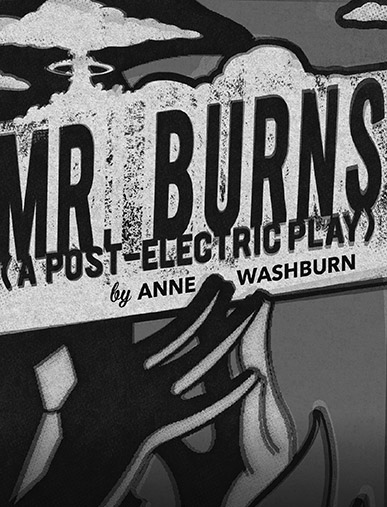Mr. Burns electrifies at Overture Center

April 20, 2016
“Mr. Burns, A Post-Electric Play” is one of those shows that sounds weirder the more you learn about it. If you’ve seen a poster or heard anything, you probably know that “The Simpsons” is involved, which from the get-go promises that the show is going to be odd.
Then you hear that religion, theater, storytelling and a nuclear wasteland are also key story elements, and maybe some Gilbert and Sullivan and recent pop music, and it was around that time I decided that yes, I really did have to see this one.
While I’ve seen a few episodes of “The Simpsons” I am far from a connoisseur, so I was surprised my pop culture illiteracy didn’t detract from the experience at all. “Mr. Burns,” while using “The Simpsons” mythology as a base, is careful to weave all the necessary information about the show into the first act (without being tedious for those already in the know). While I’m sure there were plenty of in-jokes and references that went over my head that would enliven the experience of a die-hard fan, they were not so obvious that I felt I was missing anything.
More than Simpsons trivia, I found that my Anthropology of Myth, Magic & Religion class here at Madison College deepened my appreciation and understanding of the events of the play. The morning before I saw the show I was in class with Luke Matthews talking about how religions borrow from each other and develop, especially in times of oppression. Specifically, we talked about the development of voodoo (or vodun, as we learned it is actually called) in colonial and post-revolution Haiti.
While colonial slavery and post-apocalyptic anarchy are not exactly the same thing, they both involve people being torn from their regular lives and thrown together with a bunch of other people they may only share a cultural language with. In the face of austerity, you band together and share the stories you came with, whether they’re from African tribal religions or yellow cartoons.
Haitian vodun is the originator of the classic zombie that now proliferates pop culture. Unlike the Hollywood zombie, which many have suggested is a manifestation of our anxiety of our own consumer culture, the Haitian zombie manifested anxieties of mindless servitude and loss of will. In effect, slavery. Who then, in the world of nuclear fallout presented in “Mr. Burns” would manifest the anxieties of the few survivors? The answer to this question shifts over the years as the context of the characters changes.
“Mr. Burns” has three acts: one just a few months after everything falls apart and the beginning of the ‘post-electric’ world, one seven years after the fallout and the last 75 years after. Each time the way the characters relate to the innocuous cartoon changes, from meticulous group recollection in the cold outdoors where it feels almost like camp, to collaborative imitation of the lost age of television, embracing ‘found spaces’ like abandoned gymnasiums, to the far future that is strange and has only heard of our characters and technologies through the stories of their grandparents.
Watching the performance, in addition to being enthralled and entertained, I was delighted by all the ways I could connect the ideas I have learned in my anthropology and theater classes to the ideas of the story.
Though you don’t need to know any of the referenced materials before seeing the show, I highly recommend going to the pre-performance talk. Learning about the production process and the creative motivations of playwright Anne Washburn provided even more ammunition of engaged and excited watching. Stay for the talkback, too, this is a play that begs to be discussed.
“Mr. Burns, A Post-Electric Play,” presented by Forward Theater, is playing at the Overture Center through Apr. 24.
Student tickets are $25.






























